GODDARD LIBRARY AT CLARK UNIVERSITY IN WORCESTER, MASS.
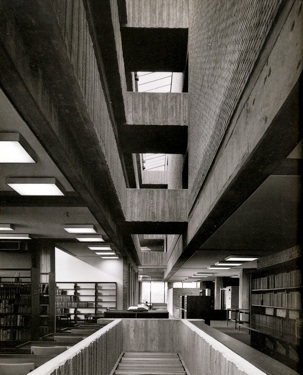








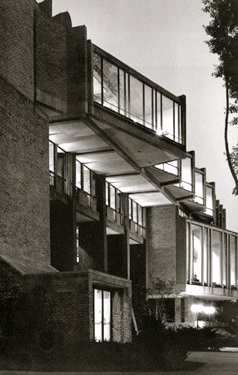








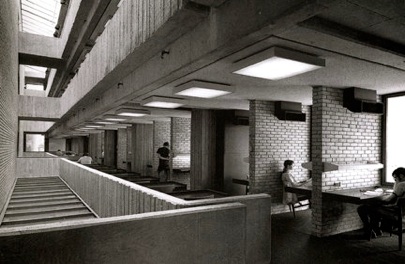








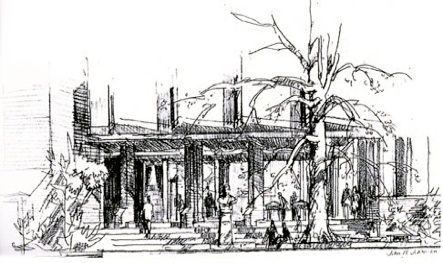








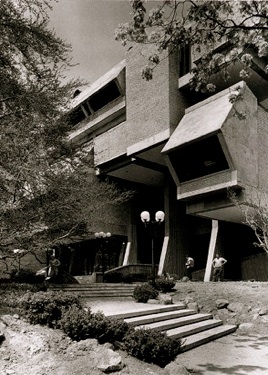








Kevin C Lippert commentS
“If the rhetoric derived from systems theory, the tectonic vocabulary was pure brutalism: Johansen described the elevations, admiringly, as ‘ like the rear side of a Xerox copier with the components and their connections rigged on a structural chassis and simply exposed.’ The ‘push and pull ’ external aesthetic treatment, resulting in highly articulated facades-glass reading rooms angled out on the west, carrels protruding on the east-were lavishly praised at the time: Melvin Charney heralded the ‘frank accumulation of the parts’.”
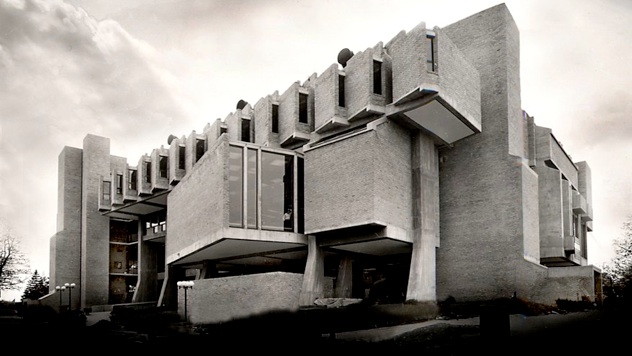








...I have, on occasion, spoken of the Goddard Library not as a building, but rather as an assemblage of components plugged into an armature as in electronic devices. This is a building not of the passing mechanical age, but of the electronic age. This library is not a device of automation (as libraries of the future may be). Still, its elevations are like the rear side of a Xerox copier with the components and their connections rigged on a structural chassis and simply exposed.
In the Goddard Library I moved toward a more articulated design by emphasizing the distinction between the ponderous structural frame and other elements that appear to be less firmly attached, conceivably detachable, or interchangable parts. The casual disposition of the parts, I spoke of at the time, as “anticompositional architecture,” and in doing so I was quite consciously attuned to the revolutionary movements within the arts, literature, science, and theology of the 1960s. My recognition of this new thinking was published in Architectural Forum in 1966, in an article entitled, “John M Johansen Declares Himself.” It also helped me to in developing my design philosophy. - John M Johansen
A CENTRAL BOX OF BOOKS
The Goddard Library is a natural and inevitable expression of concepts and experiences as I felt them. Held up one story off the ground, the building stands astride the confluence of the major pathways of the campus. Its central position is appropriate: it serves all departments of the university; it is the symbol of academic wealth. Accordingly, the central portion of the library is an enclosed and protected treasury, a three-story 'box of books’. Around the box is a continuous outer structure of reading spaces, held up range upon range by separate systems of concrete piers. This outer structure is a free assemblage, a loosely attached cluster of enclosures to accommodate an intricate program of specialized studies.
During the course of design, the program was modified and enlarged so that there was, quite literally, a process of growth, improvisation, and change. The building itself expresses this. On encountering the final form, there is a feeling that one has come upon the various parts of the building in the process of assembly or attachment. The form is evolving and alive, not fully at rest. It is, in the terms of Systems theory, a configuration: an integrated whole whose ultimate value is greater than the sum of the properties and functions of its parts.
The central box of books is the lodestone which sets the polarization of the peripheral elements. Yet the south side takes an independent angle and is figuratively out of the polar field and drawn apart as it were, by mysterious magnetic forces of the adjoining building complex. There is the 'element of the unresolved. The faculty lounge, a belated addition to the program, is propped up on one lofty pier, literally an impudent intrusion on the then accepted architectural scheme.
This is my first modern building. By that I mean it is the first that is attuned to contemporary thinking in science, in philosophy, in the arts. I regard my earlier works as Renaissance buildings by comparison. I did not willfully 'design' this library. Rather, I presided and guided the building as it developed, letting it exercise its growing confidence and will and assert its purpose. At that time I shared the idea of 'existence will' with my close friend Louis Kahn. The building does not attempt outright to be architecture, in the sense of a work of Fine Art, a thing of good taste or of beauty. It represents an attempt by the building and myself to find the essential nature of library. As a finished building, it is simply doing a job; it is performing.
- John M Johansen, FAIA
Website Copyright © 2011 John M Johansen All Rights Reserved
No information, photos, videos or audio on this website may be distributed, copied
or otherwise used without the written permission of John M Johansen or his representative
Website created by John Veltri and Marguerite Lorimer EarthAlive Communications www.earthalive.com
Please direct inquires to info@earthalive.com











Goddard Library plans - John M Johansen, FAIA
In biological terms, one might describe the [building’s] assemblage as an accretion of shells (enclosures) or as barnacles attaching themselves to a rock of their own free will. The will at work here is the will of the occupants as a collective organism, rather than the will of an egotistic fine-arts minded architect. The elevations are uncomposed. Except as they respond to the program, arrangements are accidental, haphazard, to be added to or subtracted from. There is certainly tolerance for error. - John M Johansen, FAIA
Sibyl Moholy-Nagy liked the building, though for other reasons: “The exterior of the library building is composed... However there is in these exteriors a true dynamism in the original meaning of ‘a universe constituted by immanent forces’ which is particularly effective at night. There is nothing ‘accidental, haphazard, unresolved’ in these side-views. They are simply excellent design... It will remain the greatness of John Johansen that he had the intelligence and the courage to test his contribution against the dominant forces of contemporary society. If the result is as ambiguous as our role in history, we gratefully accept clarifying function.
The shuttering of glass areas for sun control, resulting in four different elevations, evolved as naturally as does the adjustment of a fixed organism to the various condition of its environment. Specialized treatment is given spaces for specialized use: the microfilm reading room is nearly without light; the music room on the north has no sun control for reading; the art room has a full skylight to provide studio conditions; lounges have a view; all reading rooms have full protection from direct sun.”
Clark University's Goddard Library in Worcester, Mass., was named for Robert H Goddard, a rockateer and professor of physics
at the University. The library was opened on May 19, 1969 by United States Senator Ted Kennedy. © photo John Veltri






















Building as Living OrganisM
“Johansen places himself firmly on the side of letting the unpredictable happen, without preconceptions of order. Even the sometimes cantankerous Sibyl Moholy-Nagy found in the exteriors ‘a true dynamism,’ although she derided Johansen's description of the building as ‘a combination of rigidly predetermined, dehumanized solutions of electronic devices' coupled with an adolescent romanticism, addicted to the unpredictable happening, without preconceptions of order.
It is at the Clark that we see the first inklings of Johansen's coupling of scientific theory with his already well-developed interest in structural exhibitionism. This interest in systematics found freer expression in other, non-institutional projects. The admiration of Archigram was mutual, and Johansen felt that they, along with the English-based Team 10 and the Japanese Metabolists, had ‘awakened architecture to new ideas.’ Founded in 1960, Archigram shook the architectural world on both sides of the ocean with its comic-book images of intricate architectural structures ranging in size from the personal to the colossal. Among these, founding member Peter Cook's Plug-in City of 1963-64, infinitely changeable by plugging or unplugging habitable capsules by means of cranes carried on tracks across vast multistoried structures, had special resonance for Johansen.”
REMARKS BY PETER BLAKE
